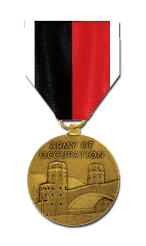
Establishing Authority
The Army of Occupation Medal was established by War Department General Orders Number 32 (1946).
Effective Dates
The Army of Occupation Medal was awarded for qualifying service in the countries listed below between the inclusive dates shown:
- Germany (May 9, 1945 to May 5, 1955)
- Austria (May 9, 1945 to July 7, 1955)
- Berlin (May 9, 1945 to October 3, 1990)
- Italy (May 9, 1945 to September 15, 1947)
- Japan (September 3, 1945 to April 27, 1952)
- Korea (September 3, 1945 to June 29, 1949)
Criteria
The Army of Occupation Medal was awarded for military service of thirty or more consecutive days of duty in one of the occupied territories after World War II.
Order of Precedence
The Army of Occupation Medal is worn after the World War II Victory Medal and before the Medal for Humane Action.
Devices
Two clasps were authorized for wear on the suspension ribbon to the Army of Occupation Medal: GERMANY and JAPAN.
The Berlin Airlift Device (a gilt C-54 aircraft with a 3/8 inch wingspan). This device is worn with the aircraft's nose pointed upward at a thirty degree angle toward the wearer's right shoulder. It was given for ninety or more consecutive days service between June 26, 1948, and September 30, 1949, while assigned or attached to a unit participating in the Berlin Airlift.
Designer
The Army of Occupation Medal was designed by Thomas Hudson Jones (1892-1969).
First Recipients
The first Army of Occupation Medal was presented to General Dwight D. Eisenhower on April 2, 1947; the second was forwarded on April 2, 1947, to General Douglas MacArthur.
Description and Symbolism
Obverse
In the center of a bronze medallion one and a quarter inches in diameter, a bridge is shown with its towers to the viewer's left (the bridge itself extends to the right rim of the medal). Above the bridge, in two lines, are the words ARMY OF / OCCUPATION.
The bridge was the Ludendorff railroad bridge at Remagen, Germany and was situated 22 miles northwest of Koblenz. On March 7, 1945, the Allies established their first bridgehead across the Rhine by seizing the Ludendorff railroad bridge at Remagen before the Germans could destroy it. Since this bridge was "point of entry" of ground forced into Germany, it was selected to represent the occupation of Germany.
Reverse
In the center of a bronze medallion one and a quarter inches in diameter, two Japanese fishing boats are depicted in full sail in front of a volcano. The date 1945 appears in the exergue.
The scene portrayed on the reverse is Fujiyama, an extinct volcano in south central Honshu, Shizuoka Prefecture, 70 miles southwest of Tokyo. It is the highest peak in Japan. The two boats are sailing on one of the five small lakes at the base of Fujiyama. This scene is symbolic of Japan, or the Army of Occupation in Asia. The date denotes the beginning year of the Army of Occupation.
Ribbon
The ribbon to Army of Occupation Medal consists of equal portion of red and black with white edge stripes. The colors are taken from the American Campaign Medal, where they appear as pinstripes inside each edge. The red and white represent Japan and the black and white represent Germany, the primary opponents of the United States during the Second World War, and the primary countries occupied after the war.